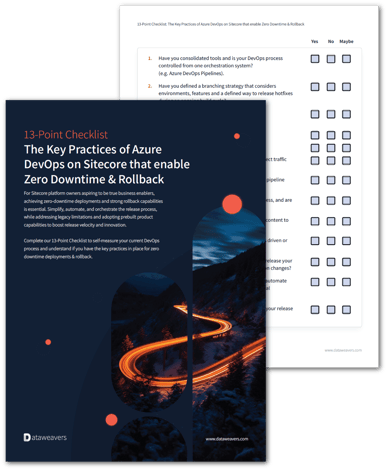Having proven Continuous Integration and Continuous Deployment (CI/CD) in a Sitecore application is like a conveyor belt in a factory, where each component is precisely timed and synchronized to ensure the delivery of high-quality products.
With a proven CI/CD pipeline, the build and release process flows seamlessly from start to finish, with quality checks, and standardized deployments that are predictable, reliable and repeatable. Just as a well-functioning conveyor belt is essential for a successful manufacturing process, a proven CI/CD pipeline is essential for a successful release in the Sitecore environment.
Getting ahead of your Sitecore platform
CMO’s and Digital Leaders, have been clear. They want seamless, stable releases from the Digital team, with no down time and more consistency. They want to be seen as business enablers delivering flawless digital experiences backed by consistent availability in an end-to-end stack. From our research, we have found that many of these Digital Leaders have very low trust levels for their own deployment processes. This lack of trust stifles their ability to innovate, move quickly and take advantage.
What they want is set of characteristics that define how new features get released:
- Automation by default
- Proven technology and process for reduced risk
- Testing to be built in
- Deployments should be secure before, during and afterwards.
- Simple effective rollbacks
- A release should not be an event, it should be an activity.
Despite their desire to support these needs, many of the platform owners and their digital teams struggle to stay ahead of the technology. They contend with an unreliable infrastructure featuring haphazard releases—partly manual and partly automated—that escalate technical debt and redirect focus towards maintaining the solution, the infrastructure and supporting the environment, rather than constructing the next valuable digital experience.
To overcome these challenges, platform owners need to establish flawless deployment processes, that enable them to make decisions with velocity on a platform they can trust.
So, as a platform owner, how can you:
- Minimize risk
- Optimize performance
- Maximise platform value, and
- Provide certainty and peace of mind?
The first step to making this happen by using proven CI/CD pipelines in the Sitecore application and infrastructure environment.
Why is CI/CD so important when it comes to website downtime?
Continuous Integration and Continuous Deployment pipelines (CI/CD), are tools that enable the automated building, testing, and deployment of applications in a consistent and repeatable manner.
The aim is to create a hands-off completely automated way to release new versions of your customisations, templates and code, ideally with no downtime, or manual intervention in the process.
The CI/CD pipelines within a Sitecore application environment play an essential role in ensuring that new code is tested, integrated, and deployed efficiently into these highly complex environments. It gives developers the ability to merge code changes into the main branch, automatically test the application, and then deploy it to the production environment. Ideally with Zero down time.
A proven process for CI/CD pipelines
A proven CI/CD pipeline means that the organization has a well-established and tested process in place for continuously building, testing, and deploying code changes. Having a proven process can minimize risk by catching bugs and issues early in the development process, reduce the time and effort required to deploy new features, and provide certainty and peace of mind for platform owners and their digital teams.
This leads to better optimization of performance, maximization of platform value, and ultimately, more innovative, and valuable digital experiences.
Why are your CI/CD Pipelines more complex than they should be?
While the benefits are clear, we know that digital teams often struggle to implement a successful CI/CD pipeline that reduces complexity of their Sitecore environment. Doing CI/CD right for Sitecore solutions, is viewed as hard.
This is because there are several unique considerations and many moving parts, including:
- How do we ensure updates go to all my Server roles as needed?
- What do we do about serialization, can I automate it as well?
- How do we establish blue green, so I can verify the outputs and roll back or proceed?
- How do we deploy patches?
- What about the head in a headless solution?
- How do I maintain security in the target environment while deploying?
When faced with this reality often the Economics of Automation is over-looked by teams. The real value in removing even one manual step (that takes only 30 minutes execute each time). This is often only considered for the immediate project and not over the lifespan of the solution. The incremental effect of doing this right, not only from a stability perspective, but as a time saver can be game changing.
Additionally, the true effort and cost required to fully automate is mostly overestimated, especially when teams are starting from scratch or trying to implement best practices for the first time with Sitecore.
This is where specialized, pragmatic, prebuilt product capabilities like Dataweavers WebOps come into play. We have already codified all these key aspects, making automation feasible and efficient.
The following outlines the key challenges we see in DevOps at Sitecore customers:
Lack of standardization
One of the primary challenges is the lack of standardization across different internal teams and their agencies. In some cases, each team may have its own CI/CD processes and tools, which can lead to inconsistencies, and removes the benefit of organisational knowledge. Often, we find overly complex Tool chains mixed with a myriad of manual processes, that has collected over time.
Too many tools
The issue lies in the complexity of tool transitions, leading to inefficient cross-tool handovers and integrations. As a result, numerous manual interim steps, or post-deployment "final configuration" steps tend to exist. It's essential to take a step back and examine the entire process. Striving for a unified tool chain that orchestrates both your CI and CD processes holds immense significance.
Security and compliance gaps
The use of Static Application Security Testing tooling as part of the CI process to analyse the source code, is well documented. Making sure that the code written has no security vulnerabilities. There is a risk of introducing security vulnerabilities or non-compliance issues if proper checks and balances are not in place. This can lead to additional reviews, delays, and rework, which can slow down the pipeline and cause disharmony both within development teams and into other team relationships like marketing and technology.
Skill gaps
Implementing CI/CD pipelines will require specialized Platform Engineering and Reliability Engineering skills encompassing DevOps, automation, infrastructure, and security. Digital teams may struggle to find or develop the necessary skills to implement a pipeline and process that benefits the business rather than causing more complications.
Options for your CI/CD Path forward
It’s clear that the path forward for many businesses with unstable deployments is to invest in the tooling, skills, team, process and efficiency. The alternative is the Dataweavers WebOps Product, where Proven CI/CD has already been solved and is part of the product (among other operational benefits).
Dataweavers acts as the single entity point responsible for effective build and release into your environment.
How we can help you get started
Download our 13 Key Practice Checklist for Sitecore, to self-measure where you land in your current DevOps process:
.jpg)






